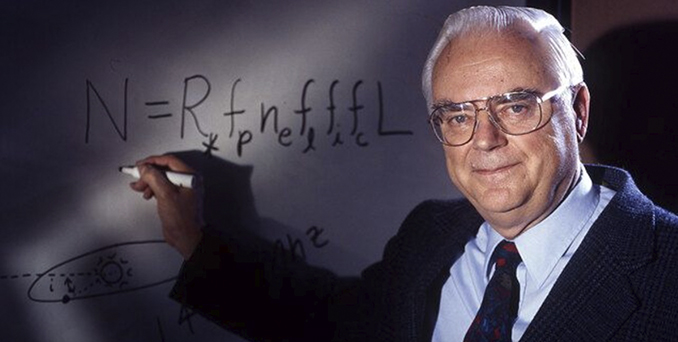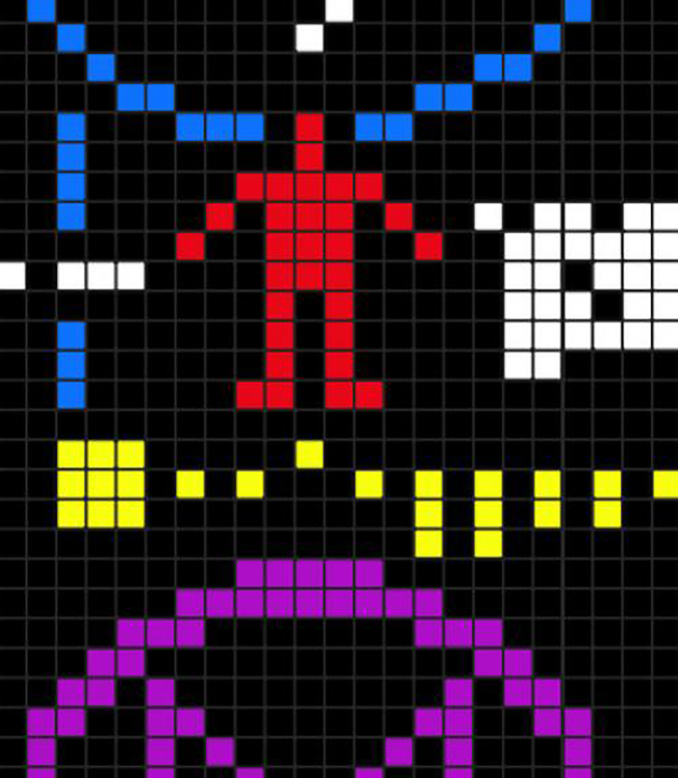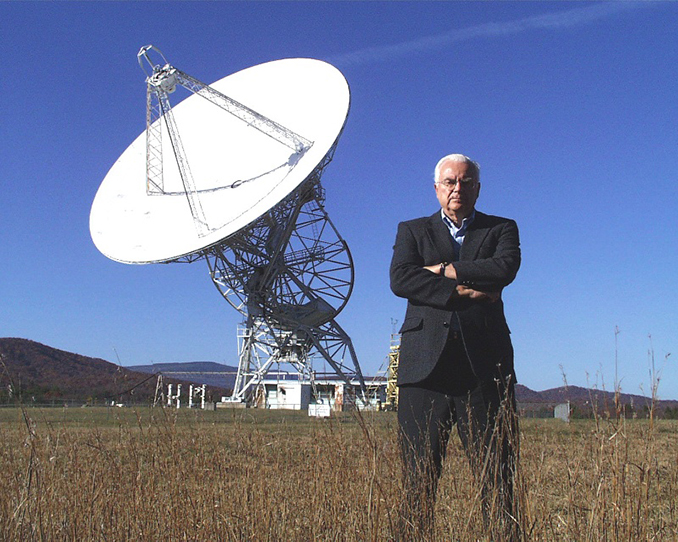
Frank Drake, the radio astronomer who pioneered the search for extraterrestrial intelligence (SETI), died yesterday (2 September) at the age of 92.
Born on 28 May 1930 in Chicago, Drake was working at the Green Bank Radio Telescope during the early days of radio astronomy, in the late 1950s, when he was inspired by Giuseppe Cocconi and Philip Morrison’s famous 1959 paper in Nature about using radio transmissions at 21cm wavelength to communicate across interstellar distances. Encouraged by the director of Green Bank, Otto Struve, Drake conducted the first ever radio SETI search in April 1960. Called Project Ozma, the search utilised the 26-metre dish at Green Bank to scan two nearby stars, epsilon Eridani and tau Ceti, for extraterrestrial radio transmissions. Drake thought he had hit pay-dirt on day one, with the detection of an anomalous, pulsed signal coming from the direction of epsilon Eridani. However, the signal turned out to be from a high-altitude aircraft instead.
The project lasted about six weeks spread across April and May, accounting for about 200 hours’ worth of observing time. Suffice to say, no bonafide extraterrestrial signals were discovered, but that didn’t put Drake off. The following year he organised a SETI conference at Green Bank at the behest of J. Peter Pearman of the National Academy of Sciences. Invited to the meeting were such luminaries as a young Carl Sagan, Cocconi and Morrison who had kicked the whole thing off with their Nature paper, electronics scientist Dana Atchley, Barney Oliver of Hewlett-Packard, the biochemist Melvin Calvin, controversial neuroscientist John Lily, and of course Drake and Struve.
But days before the meeting, Drake realised that they needed a more coherent agenda, so he set about creating a framework based on what he thought were the salient questions that needed answering before we could say whether SETI might be successful.
If extraterrestrial life existed, then it seemed reasonable to expect that it would live on planets, orbiting stars, so knowing the rate at which stars form seemed a good starting point. Then, how many of those stars form planets? How many of those planets are temperate like Earth, and how many ultimately develop simple life? Then, now how many of those worlds does that simple life evolve into complex, intelligent life? What fraction of those intelligent civilisations develop the technology for interstellar communication? And finally, how long do alien civilisations exist for, because the Universe is very old, and if technological civilisations don’t last long, the chances of our existence coinciding with theirs might be slim.
Drake wrote this all down, and realised he’s come up with an equation to estimate how many technological, communicative, extraterrestrial civilisations there may be out there. Though most of the factors in what has become known as the Drake Equation are completely unknown, meaning we can only guess at their values, that’s exactly the point. Unlike other scientific equations, it was never intended to provide an accurate answer, but rather to expose our ignorance and how much we still need to learn. Even to this day, we only know accurate values for the first two factors.
Although SETI was an important part of Frank Drake’s career, he was principally a radio astronomer, and in 1964 he joined Cornell University as a professor of astronomy, while at the same time leading the re-development of the Arecibo Radio Observatory from a military facility into the largest single-dish astronomical telescope in the world, acting as its director between 1966–68, and then as the director of the over-arching National Astronomy and Ionosphere Center between 1970–81

It was at Arecibo that he transmitted the famous Arecibo message in 1974 to the globular star cluster Messier 13, which is 22,000 light years away. Arecibo had just been renovated, its wire mesh bowl being replaced by a high-precision surface of aluminium panels, and as part of the re-opening ceremony, the Arecibo message was blasted into space.
The Arecibo message was a short, binary-encoded communication, containing just 551 bits that, in cryptic fashion, contained information that could tell any aliens who detected it about humankind, our biological information, where we live, and what we look like. The intention was that aliens would receive the message as a series of 1s and 0s that could be decoded into a pictogram. Drake actually lamented that he’d made the message too complex to understand; he sent it in binary code to his colleagues who’d attended the Green Bank conference, and only the formidable Barney Oliver was able to partially translate it and even send Drake a reply in kind. Then Drake sent it to a bunch of Nobel Prize winners, none of whom could decode it. Eventually, years after the message had been beamed into outer space, an amateur codebreaker saw the binary message in a magazine and completely decoded it.
“The experience taught me two things,” wrote Drake in his book ‘Is Anyone Out There?’ co-written with Dava Sobel. “(1) My message was too crowded and too confusing; and (2) on such a day as we actually receive an extraterrestrial message, we should be sure to involve enthusiastic amateur codebreakers in its interpretation.”
But Drake’s days of sending messages to aliens weren’t over. In 1972 he’d worked with Carl Sagan and Linda Salzman Sagan to design the Pioneer plaques that were attached to the Pioneer 10 and 11 missions to the outer Solar System and which are now heading into interstellar space. The plaques proved controversial with prudes for featuring naked humans, but more pertinently the plaques also contained information about where aliens could find Earth. Then, prior to the launch of the Voyager 1 and 2 missions in 1977, he worked with Sagan again on the Voyager Golden Record, which contained a selection of music, sounds and pictures of Earth for aliens to listen to.
Drake left Cornell in 1984 to take up a new post at the University of California, Santa Cruz, and remained there as Emeritus Professor after he retired in 1996. After moving to California, he also acted as the Director of the SETI Institute’s Carl Sagan Center for the Study of Life in the Universe, and then later as the Chair of the SETI Institute’s board of trustees.
In his later years he continued to be prominent in the SETI community, acting as a public figurehead. Often called the ‘father of SETI’, his name will live on in his contributions to how we think about life beyond Earth, and how we search for evidence that we are not alone. Although we are continue to be met with silence, Drake never lost his optimism, as he showed in his words in Is Anyone Out There?
“The silence we have heard so far is not in any way significant,” he and Sobel wrote. “We still have not looked long enough or hard enough. We’ve not explored a large enough chunk of the cosmic haystack … The goal is not beyond us. It is within our grasp.”




